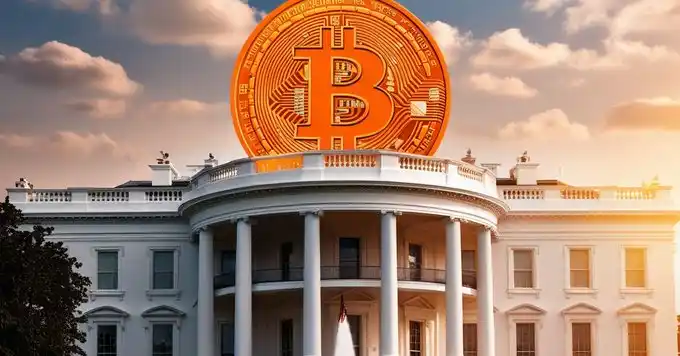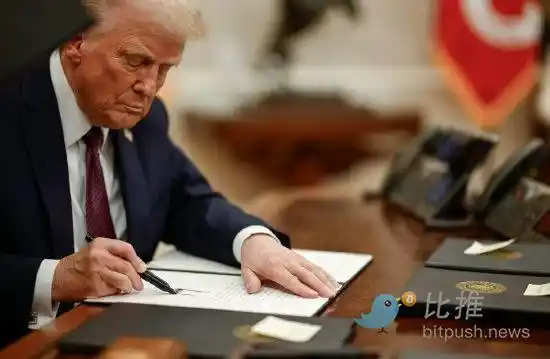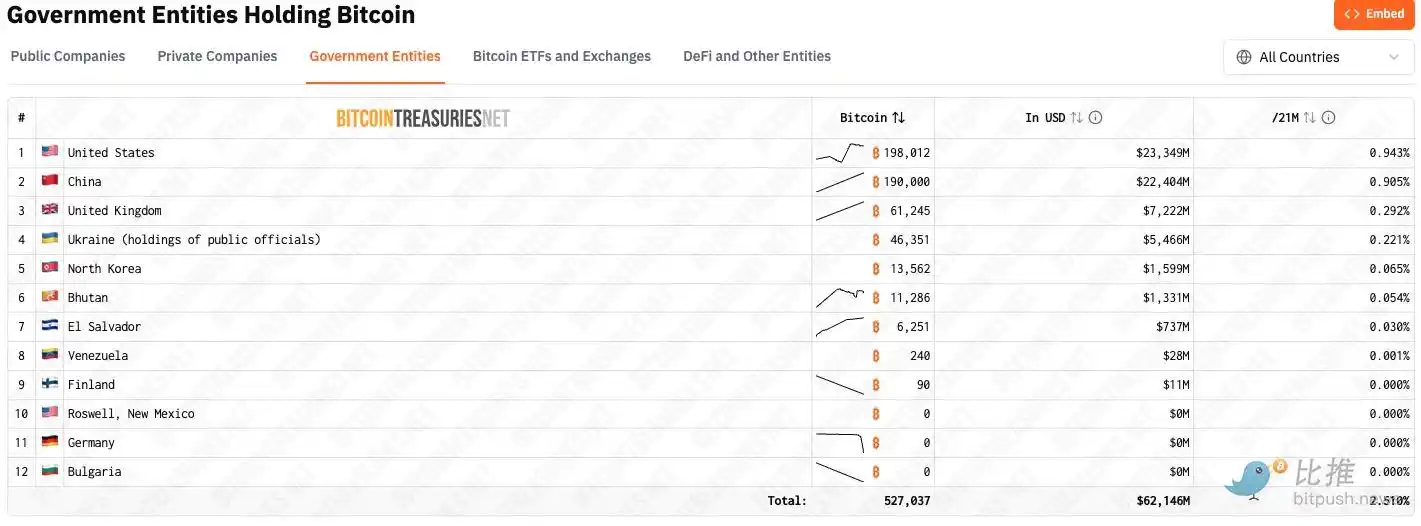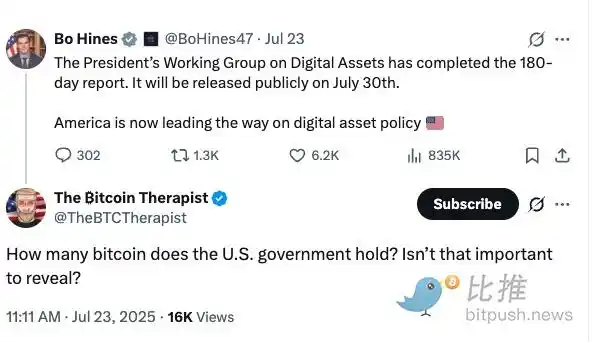Original Title: "White House Crypto Report Imminent: Will the U.S. Government's Bitcoin 'Assets' Be Exposed?"
Original Source: BitpushNews
On July 30, Eastern Time, a document that the crypto industry has high hopes for is about to be released—the White House's first digital asset policy report. This report not only represents the first systematic expression of the Trump administration's stance on cryptocurrency regulation but is also seen as a potential roadmap for the industry's development in the coming years.
This upcoming report stands out amid various legislative progress and regulatory games, and its impact may far exceed the regulation itself.

Top-Level Design Born from Executive Order: Starting with Executive Order 14178
In January of this year, U.S. President Trump signed Executive Order 14178, officially calling for the establishment of a "Presidential Digital Asset Working Group" led by the Secretary of the Treasury. This group includes several core regulators, such as the SEC Chair and the Secretary of Commerce, with the mission to comprehensively assess the development of digital assets and propose targeted policy recommendations.

Now, after 180 days of preparation, this significant report is finally about to be released. Bo Hines, the Executive Director of Crypto Affairs at the White House, has confirmed on social media that it will be officially announced on July 30, stating that "the U.S. is leading the global digital asset policy trend."
The timing of the report's release is also quite subtle—key legislations such as the GENIUS Act and the CLARITY Act are making substantial breakthroughs, and the dual push of executive orders and legislation sends a strong policy signal: the U.S. is no longer observing digital asset governance but is fully intervening.
The Core of Industry Attention: The Era of Regulatory "Clarity" Has Arrived
After years of regulatory ambiguity and multi-party games, the industry's most urgent expectation for this report focuses on "clarity" and "boundaries."
Cody Carbone, CEO of the Digital Chamber of Commerce, bluntly stated: this will be "the guiding document for all relevant regulations and guidelines for the next three and a half years."
From the existing information, the report is expected to focus on the following four major areas:
- Stablecoin Regulatory Framework
The report may propose institutional designs regarding the issuance thresholds, reserve mechanisms, and audit transparency of dollar-pegged stablecoins, laying the foundation for the expanding stablecoin ecosystem.
- Bank Access and Cooperation Mechanisms
Regarding the "legal identity" issues of crypto enterprises in bank accounts and payment channels, the report is expected to propose policy ideas for integration with traditional finance while strengthening risk isolation.
- National Security Perspective
Addressing potential issues of digital assets in cross-border transactions, sanctions evasion, and money laundering risks, the report will emphasize the construction of "compliance technology" and promote the alignment of technological means with regulatory needs.
- Technological Neutrality and Regulatory Boundary Definition
"Regulating by function rather than technology" may become the main tone of the report, clarifying the functional boundaries of various regulatory agencies and addressing the long-standing issues of "multi-party management" and "regulatory gaps" that have troubled the industry for years.
Cody Carbone pointed out that if the bottom line of "what can and cannot be done" can be clarified, it will greatly enhance industry confidence.
The Holding Mystery: How Much BTC Does the U.S. Government Actually Hold?
In addition to the regulatory blueprint, another highly anticipated part of the report is the first official disclosure regarding the U.S. government's crypto asset holdings.
For years, the claim that "the U.S. government holds the most Bitcoin in the world" has been widely circulated online. According to the platform BitcoinTreasuries, the U.S. government's holdings are estimated to be around 198,000 BTC, far exceeding other countries.

However, independent journalist L0la L33tz recently applied for holding data from the Department of Justice through the Freedom of Information Act (FOIA), and the result showed that the Department of Justice only has 28,988 Bitcoins. This number is far below market expectations, raising the question, "Have nearly 170,000 Bitcoins been sold?" (For details, refer to this article: Did the U.S. Marshals secretly sell 170,000 BTC? Is an epic replenishment coming?!)
A more neutral explanation comes from community user Shifu Dumo. He believes that the FOIA data only reflects the portion currently liquidable by the U.S. Marshals Service (USMS), a subordinate agency of the Department of Justice. Some assets may have been frozen, used for compensating victims, or held by other agencies, and are not included in the Department of Justice's reports.
However, this also means that the actual number of Bitcoins belonging to the U.S. federal government, which can be used for "national strategic reserves," may be far lower than the public imagines.
Crypto commentator "The ₿itcoin Therapist" directly asked Bo Hines, the Executive Director of Crypto Affairs at the White House, on social media: "How much Bitcoin does the U.S. government hold? Isn't it important to reveal this?" This statement fully expresses the community's desire for transparency.
This upcoming White House report is expected to reveal the true situation regarding the U.S. government's Bitcoin holdings and provide an official explanation for these "missing" Bitcoins, thereby answering long-standing market questions.

Industry Reaction: A Signal of Entering the "Adoption Phase"
The industry response to this forthcoming report is generally positive. Summer Mersinger, CEO of the Blockchain Association, believes it marks the substantial implementation phase of the crypto executive order.
Ron Hammond, policy director at Wintermute, views the report as "an important step for Trump to fulfill his promises to the crypto industry."
In the opinion of Jordi Visser, managing director at 22V Research, we are at a turning point where the crypto industry is moving from "experimentation" to "acceptance and adoption." He likens the current phase to the "ChatGPT moment" in the crypto world.
As regulatory expectations become clearer and institutional entry accelerates, Bitcoin's price has recently rebounded strongly, briefly breaking the $120,000 mark. As of the time of writing, it remains stable above $117,000, with a total market capitalization of $3.85 trillion.
This report is not only a systematic presentation of the Trump administration's crypto policy but also an important "moment" for the global crypto market. How will it find a balance between encouraging innovation and preventing risks? Will it be able to address the trust gap regarding U.S. strategic holdings? These answers are about to be revealed.
免责声明:本文章仅代表作者个人观点,不代表本平台的立场和观点。本文章仅供信息分享,不构成对任何人的任何投资建议。用户与作者之间的任何争议,与本平台无关。如网页中刊载的文章或图片涉及侵权,请提供相关的权利证明和身份证明发送邮件到support@aicoin.com,本平台相关工作人员将会进行核查。




